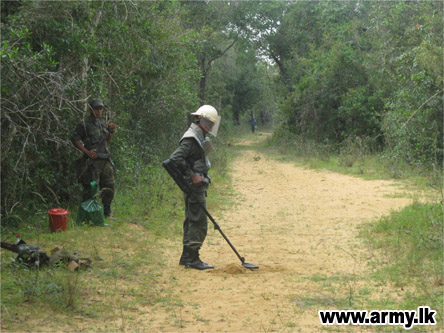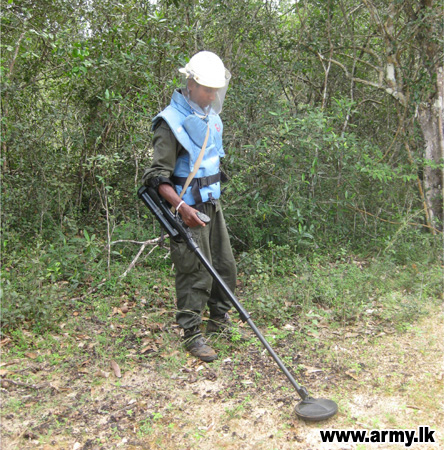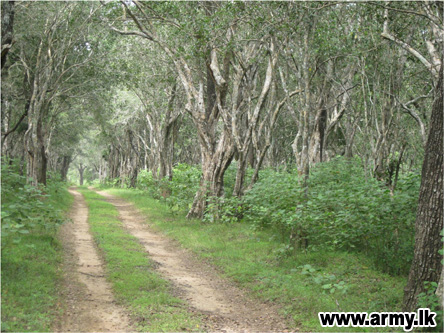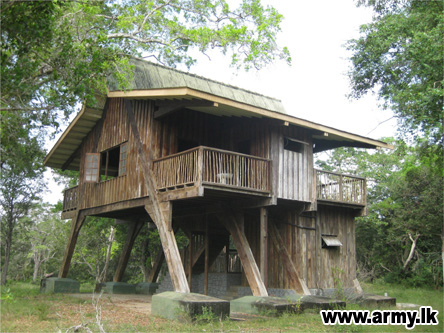DURING their unrelenting and risky operations, specifically designed to rid all kinds of buried LTTE mines and unexploded devices (UXOs) from the Wilpattu National Park, now open for visitors, professionally trained de-miners of 5 Field Engineer Regiment of Corps of Engineers have unearthed two Anti Tank Mines, three claymore mines and ninety-two P4-MK1-type anti personnel mines, in addition to many other UXOs.
Both Anti Tank Mines unearthed from the inside of the Wilpattu National Park had been schematically planted in close proximity to Katrambavilluwa, the location where Tiger terrorists after triggering a powerful pressure mine cold-bloodedly murdered seven local tourists on 26th May 2006 while they were aboard their moving jeep. Katrambavilluwa lies about 48 kms to the north, away from the main entrance along Puttalam-Anuradhapura highway.
Three claymore bombs and ninety-two Anti Personnel Mines, planted by LTTE terrorists were also recovered by de-mining teams of 5 Field Engineers Regiment from the close vicinity, surrounding Maradanmadu Circuit Bungalow in the park during their recent operations.
In the aftermath of the successful completion of the War against terrorism, Commander of the Army Lieutenant General Jagath Jayasuriya instructed Sri Lanka Army Engineers to take up the challenge of de-mining and clearing the Wilpattu National Park as early as possible. Engineers conducted an initial surveillance on the whole area and assessed the requirements. Sri Lanka Army Engineer troops, planning the entire operation under two phases, 106.1 km long motorable road areas (1st phase) and 151 km long extent covering cart track areas (2nd phase) lying inside the Wilpattu National Park boundaries, commenced their 1st phase giving its due priority and urgency.
Taking the challenge valiantly, 5 Field Engineer Regiment troops in their hundreds were inducted for the assignment on 24th December 2009 and made to complete the job by 19th January 2010. Similarly, the 2nd phase, started on 20th January 2010 focused its attention largely on 151 km long cart track areas and ended the project by 18th February 2010 before the National Park was officially released back to Department of Wildlife for onward opening arrangements. The official opening took place on 27th February.
Wilpattu sanctuary with its 3,34,000 acres in extent was declared a National Park on 5th February 1936 by a special gazette and remained a popular wildlife resort until Tiger terrorists finally infiltrated the area.
Tiger terrorists after indiscriminately shooting Buddhist devotees meditating and praying at the sacred Anuradhapura Jaya Sri Maha Bodhi, way back on 14th May 1985 fled the area on a bus before they forcibly entered Hunuvilgama wildlife range office using one boundary and butchered 18 wildlife range officials on duty at the location. All those seventeen officials were at first abducted and dragged into thick jungles before they were inhumanly shot down for no fault of theirs. In December 1988, two Police officers providing escort to the vehicle that carried salaries to wildlife officials were abducted and subsequently killed by terrorists, prompting the authorities to indefinitely shut down this world famous sanctuary for the first time in her history.
After a lapse of 15 years, this National Park with a rich wealth of bio-diversity was re-opened on 16th March 2003, but unhindered access to the park was only short-lived as Tiger terrorists on 27th May 2006 butchered seven more local tourists on a jeep at Katrambavilluwa on Manikkapolautthu-Kokmotai road that cuts across the park.
Again one more LTTE assault on 9th March 2007 in Kokkarivillu on a team of Army personnel conducting surveillance deprived the Army of one Officer and two soldiers. This crime however led to the closure of the National Park on security grounds until it was re-opened on 27th February 2010. Sri Lanka Army assures all local and foreign tourists that Wilpattu National Park is now free of all mines and other explosives and safety for the visitors.
 |
 |
 |
 |
 |

